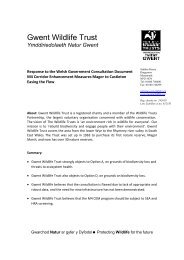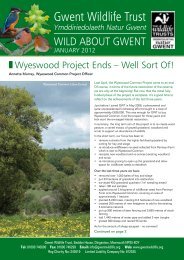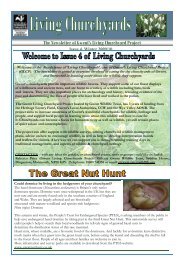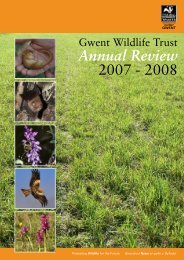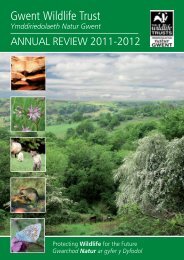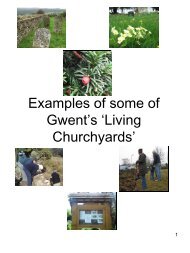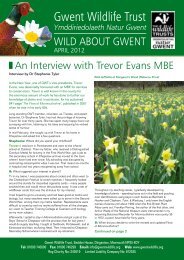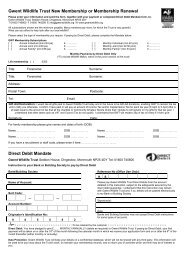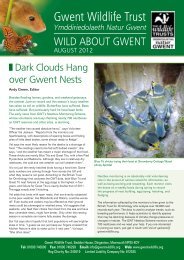Energy at any price? - Gwent Wildlife Trust
Energy at any price? - Gwent Wildlife Trust
Energy at any price? - Gwent Wildlife Trust
Create successful ePaper yourself
Turn your PDF publications into a flip-book with our unique Google optimized e-Paper software.
iStock PhotoThe global impactBirds and fish disperse the Estuary’s energy andproductivity to ecosystems across the globeEelsAfter m<strong>at</strong>uring in fresh w<strong>at</strong>er, adultsswim across the Atlantic to spawn anddie in the Sargasso Sea. The larvae arethought to return on North Atlanticcurrents. Numbers of eels havedeclined hugely in recent years, forreasons which are not fully understood.The previous pages explain how the Estuarygener<strong>at</strong>es very large amounts of biomass (thesheer weight of living things), most of it fromthe intertidal zone.Because most of the Estuary’s pred<strong>at</strong>ors arehighly mobile fish and birds, they effectivelytransport the energy and m<strong>at</strong>erial they pick upin the mud to other places. This energy andm<strong>at</strong>erial is carried in these animals’ bodytissues and guts, and transmitted via theirparticip<strong>at</strong>ion in other ecosystems where theyfeed, are fed on, and eventually die anddecompose. Millions of fish and birds movingaround is impressive enough, but they keep upthese movements year after year, and thecumul<strong>at</strong>ive effect is astronomical. Without theSevern’s effect as a stopover and refuel facility,for example, the Arctic tundra couldn’tsupport so m<strong>any</strong> migr<strong>at</strong>ory waders. Withoutits effect as a huge fish nursery, the Celtic Sea(and the Atlantic Ocean beyond) could notsupport so m<strong>any</strong> salmon, spr<strong>at</strong>s or mackerel.This extreme interconnectedness is wh<strong>at</strong>makes altering the Severn’s intertidal habit<strong>at</strong> sorisky. Does the Estuary’s energy prize justifysevering these global wildlife links, with theirbenefits to people which are not yet fullyunderstood?Dispersal happens across the UK tooLittle is known of the eel’s migr<strong>at</strong>ion routesSalmonPrincipal feeding grounds are north ofthe Faeroes; adults are <strong>at</strong> sea for up tofour years. Most popul<strong>at</strong>ions are indecline. The sea trout, another migrant,is thought to stay near the UK coast, asdo the allis and twaite shad (the Severnshad are genetically distinct species).Mike LanePREVIOUS PAGEThe <strong>Gwent</strong> LevelsHabit<strong>at</strong> for a huge diversityof birds. M<strong>any</strong> are relianton the Estuary’s mudfl<strong>at</strong>sfor their source of foodThe Severn’s tributariesThe rivers are fine habit<strong>at</strong>sfor resident and migr<strong>at</strong>oryfish which feed in (andpass through) the EstuaryThe Somerset LevelsThe Levels and the RiverParrett are excellenthabit<strong>at</strong>s for resident andmigr<strong>at</strong>ory birds, m<strong>any</strong> ofwhich feed in the EstuaryThe local effectAnimal movements disperse largequantities of energy and m<strong>at</strong>erialfrom the Severn Estuary toneighbouring systems in theregion. The key areas to benefitare the rivers Parrett in Somerset,Usk in Wales, the Wye either sideof the border, and the <strong>Gwent</strong> andSomerset LevelsReasons for salmon declines are complexBirdsWith several dozen species andsub-popul<strong>at</strong>ions involved, the routesshown here are hugely simplified. Butessentially there are three sorts of birdmigr<strong>at</strong>ion through the Estuary.The spring passage from Africa,branching west to breeding grounds inIceland and Greenland, or east tonorthern Europe and Russia.The return journey, from l<strong>at</strong>e June toOctober, by adults and young.The winter visitors, which don’t gofurther south than the Estuary, andreturn north in spring to breed.Bar-tailed godwits: 300 grams of pure energyLaurie CampbellColin VarndellNEXT PAGE18 The <strong>Wildlife</strong> <strong>Trust</strong>s’ Severn Estuary reportThe <strong>Wildlife</strong> <strong>Trust</strong>s’ Severn Estuary report 19



